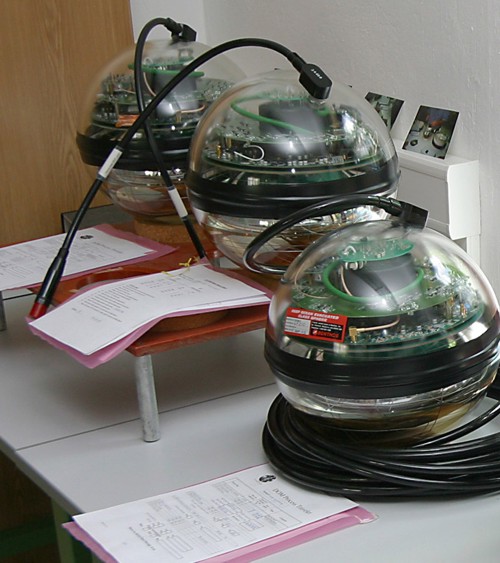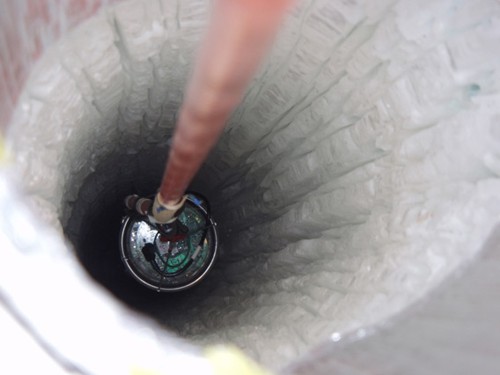
| NEUTRINOS, SANATKUMARS AND DEV RISHI NARAD Neutrinos
:
Neutrinos are similar to the more familiar electron, with one crucial
difference: neutrinos do not carry electric charge. Because neutrinos
are electrically neutral, they are not affected by the electromagnetic
forces which act on electrons. Neutrinos are affected only by a
"weak" sub-atomic force of much shorter range than electromagnetism,
and are therefore able to pass through great distances in matter
without being affected by it. If neutrinos have mass, they also
interact gravitationally with other massive particles, but gravity
is by far the weakest of the four known forces.
Neutrinos
are subatomic particles, and they’re weird. They don’t
interact with matter very much, so to them most of the Universe
is transparent. They can pass right through the Earth without even
noticing.
Other neutrinos are constantly being produced from nuclear power stations, particle accelerators, nuclear bombs, general atmospheric phenomena and during the births, collisions, and deaths of stars, particularly the explosions of supernovae.
Really though to them the Universe is only mostly transparent. There’s a very little chance they’ll interact with matter. If you have enough neutrinos, a small number of them can ping off an atomic nucleus and create an effect we can measure. The good news is there are a lot of neutrinos flying around all the time. Billions of them are passing through you right now!
That makes them possible to detect if you are patient and careful. Happily, scientists are both. Neutrino detectors have been assembled in various parts of the world and have been pretty successful in finding the little suckers. They use various methods to see them; for example, some use the fact that when a neutrino slams into a chlorine nucleus, it can change it into an argon nucleus. Those detectors need huge amounts of chlorine for this, so they use tetrachloroethylene: dry cleaning fluid!
But the news today comes from a different kind of detector. This one relies on the idea that a neutrino passing through ice can create a shower of subatomic particles, like shrapnel. These particles scream out from the collision and can actually travel faster than light through the ice. This sounds impossible, but light speed is the Universal limit when it’s traveling through a vacuum. Light slows down when passing through air, or liquid, or matter. So a subatomic particle can travel faster than light through matter, while still traveling slower than light does in a vacuum.
[Note: This is all very, very different than the claim of faster-than-light neutrinos from 2011. That turned out to be due to an equipment malfunction.]
Detectors designed to see the faint flashes of light when neutrinos interact with ice When this happens, the particle creates a shock wave, just like a sonic boom is created when something travels faster than sound. In this case, though, it’s not a sonic boom, but a photonic boom, a shock wave of light. This creates a faint blue flash called Cherenkov radiation, and that can be seen using very sensitive detectors.
Scientists have built just such a device in Antarctica. It’s called (get this) Ice Cube, and it consists of a string of detectors lowered 1,500 to 2,000 meters (1 to 1.5 miles) beneath the very clear ice. At that depth the ice is very smooth and dark, making it easier to see the flash of light from a neutrino reaction.
Neutrinos
come from lots of different sources. Nuclear reactions in the Sun
produce prodigious numbers of them, as do nuclear reactors on Earth,
natural radiation from uranium decay inside the Earth, and even
more exotic phenomena like exploding stars. These neutrinos all
have different energies, so it’s possible in principle to
categorize the source by looking at how energetic the detected neutrino
is.
A detector being lowered into a hole drilled into the ice Not very many things in the Universe can make neutrinos with that much energy. Super massive black holes in the centers of galaxies are one possible candidate; they are sloppy eaters, gobbling down and spewing out fantastically high-energy beams of matter and energy. Another possible source are gamma-ray bursts; explosions of stars so violent they are second only to the Big Bang itself. These typically occur in the very distant Universe, so statistically speaking if these are the engines making these super-high-energy neutrinos, then those little particles have traveled a long, long way before hitting the ice in Antarctica.
The scientists who made this detection note that they can’t completely rule out less exotic sources; there’s a 99 percent or so certainty that these neutrinos are not from some background source. That’s not quite enough to pass the rigorous standards of particle physicists (they prefer a minimum of 99.7 percent certainty to make a claim, and really a 99.9999 percent certainty to claim discovery, like with the Higgs particle last year).
Still, it’s provocative. And what a claim! Using faster than light particles to detect ghostly but super-high-energy intergalactic particles that have traveled tens or hundreds of millions of light years, only to get trapped beneath the Antarctic ice.
Neutrino results challenge a cornerstone of Albert Einstein's special theory of relativity, which itself forms the foundation of modern physics
September 22, 2011 |By Geoff Brumfiel and Nature magazine.
Cern Cern :
An Italian experiment has unveiled evidence that fundamental particles known as neutrinos can travel faster than light. Other researchers are cautious about the result, but if it stands further scrutiny, the finding would overturn the most fundamental rule of modern physics that nothing travels faster than 299,792,458 meters per second.
The experiment is called OPERA (Oscillation Project with Emulsion-t Racking Apparatus), and lies 1,400 meters underground in the Gran Sasso National Laboratory in Italy. It is designed to study a beam of neutrinos coming from CERN, Europe's premier high-energy physics laboratory located 730 kilometers away near Geneva, Switzerland. Neutrinos are fundamental particles that are electrically neutral, rarely interact with other matter, and have a vanishingly small mass. But they are all around us the sun produces so many neutrinos as a by-product of nuclear reactions that many billions pass through your eye every second.
The
1,800-tonne OPERA detector is a complex array of electronics and
photographic emulsion plates, but the new result is simple the neutrinos
are arriving 60 nanoseconds faster than the speed of light allows.
"We are shocked," says Antonio Ereditato, a physicist
at the University of Bern in Switzerland and OPERA's spokesman.
Ereditato says that he is confident enough in the new result to make it public. The researchers claim to have measured the 730-kilometer trip between CERN and its detector to within 20 centimeters. They can measure the time of the trip to within 10 nanoseconds, and they have seen the effect in more than 16,000 events measured over the past two years. Given all this, they believe the result has a significance of six-sigma the physicists' way of saying it is certainly correct.
At least one other experiment has seen a similar effect before, albeit with a much lower confidence level. In 2007, the Main Injector Neutrino Oscillation Search (MINOS) experiment in Minnesota saw neutrinos from the particle-physics facility Fermilab in Illinois arriving slightly ahead of schedule. At the time, the MINOS team downplayed the result, in part because there was too much uncertainty in the detectors exact position to be sure of its significance, says Jenny Thomas, a spokeswoman for the experiment.
Thomas says that MINOS was already planning more accurate follow-up experiments before the latest OPERA result. "I'm hoping that we could get that going and make a measurement in a year or two," she says.
If MINOS were to confirm OPERA's find, the consequences would be enormous. "If you give up the speed of light, then the construction of special relativity falls down," says Antonino Zichichi, a theoretical physicist and emeritus professor at the University of Bologna, Italy. Zichichi speculates that the "superluminal" neutrinos detected by OPERA could be slipping through extra dimensions in space, as predicted by theories such as string theory.
Ellis, however, remains skeptical. Many experiments have looked for particles traveling faster than light speed in the past and have come up empty-handed, he says. Most troubling for OPERA is a separate analysis of a pulse of neutrinos from a nearby supernova known as 1987a. If the speeds seen by OPERA were achievable by all neutrinos, then the pulse from the supernova would have shown up years earlier than the exploding star's flash of light; instead, they arrived within hours of each other. "It's difficult to reconcile with what OPERA is seeing," Ellis says.
Ereditato says that he welcomes skepticism from outsiders, but adds that the researchers have been unable to find any other explanation for their remarkable result. "Whenever you are in these conditions, then you have to go to the community," he says.
The Kumaras are four sages (rishis) who roam the universe as children from the Puranic texts of Hinduism, generally named Sanak, Sanatan, Sanandan and Sanatkumar. They are described as the first mind-born creations and sons of the creator-god Brahma. Born from Brahma's mind, the four Kumar's undertook lifelong vows of celibacy (brahmacharya) against the wishes of their father. They are said to wander throughout the materialistic and spiritualistic universe without any desire but with purpose to teach. All four brothers studied Ved's from their childhood, and always travelled together.
Dev Rishi Narad :
Rishi Narad is regarded as the Manasaputra, referring to his birth 'from the mind of Brahma. He is regarded as the Triloka sanchaari, the ultimate nomad who roams the three lokas of Swargalok (heaven), Mrityulok (earth) and Patallok (nether-world).
The Sanatkumars and Rishi Narad can travel anywhere in the universe and no one can stop them.
When we combine religion with science we can come to conclusions that Sanatkumars and Rishi Narad are Neutrinos. |


